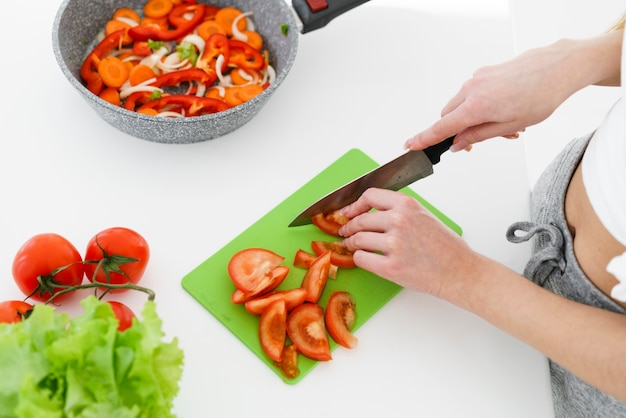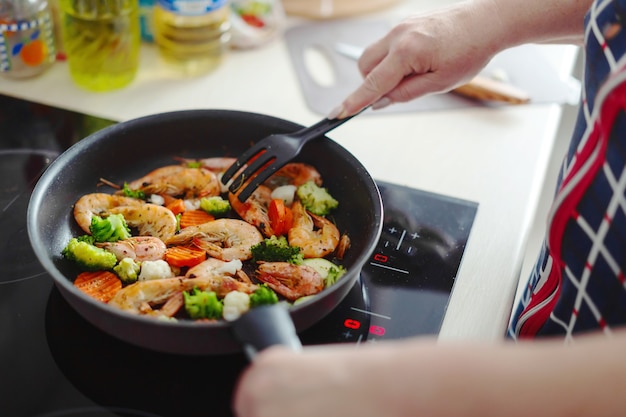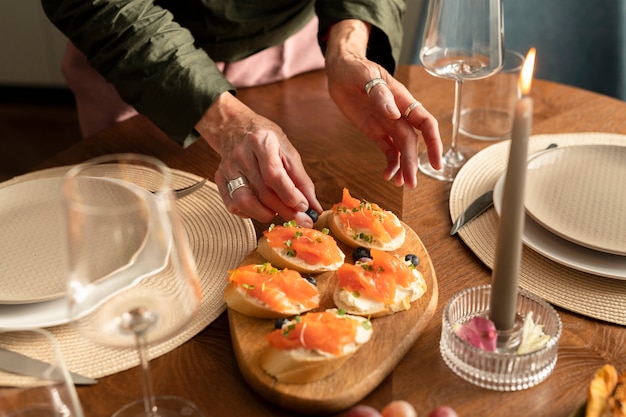As a self-proclaimed seafood aficionado, I've cooked my fair share of shrimp. From the classic garlic butter scampi to spicy Thai curries, shrimp has always been a go-to ingredient for me. But I've also had my fair share of disasters – rubbery, overcooked shrimp that was a far cry from the juicy, tender perfection I crave. So, I decided to embark on a mission to conquer the art of perfect shrimp cooking. After countless trials and errors, I've finally cracked the code, and I'm here to share my hard-earned wisdom with you.
(Part 1) Understanding Shrimp: A Journey into the World of Crustaceans

The first step to cooking perfect shrimp is understanding them. Shrimp are incredibly versatile, but they're also incredibly delicate. They cook quickly, which can be a blessing and a curse. A little too much time on the heat, and they go from succulent to rubbery in a blink of an eye. So, it's crucial to have a good grasp of their characteristics before you even start cooking.
The Importance of Freshness: A Tale of Two Shrimp
Freshness is key when it comes to shrimp. The best shrimp are firm, with a slightly translucent appearance and a mild, sweet aroma. Avoid shrimp that have a strong fishy smell or are soft and mushy. And remember, the smaller the shrimp, the faster they'll cook.
I once bought a batch of shrimp from a local market that were a little…well, less than fresh. The smell was a bit off-putting, and the texture felt mushy. I should have known better, but I tried to cook them anyway. The result? A dish that tasted like the ocean floor and left me with a stomach ache. Needless to say, I've been a lot more careful about choosing my shrimp ever since!
types of shrimp: A Global culinary adventure
There are countless varieties of shrimp, each with its own unique flavour and texture. But for the sake of simplicity, we'll focus on the most common types:
- Whiteleg Shrimp: This is the most common type of shrimp found in supermarkets. It has a mild flavour and a firm texture. It's often farmed and widely available, making it a budget-friendly option.
- Pink Shrimp: This variety is sweeter and more delicate than whiteleg shrimp, but it can be a bit pricier. It's often used in sushi and other delicate dishes, showcasing its delicate flavour.
- Tiger Shrimp: With its distinctive black stripes, tiger shrimp is a showstopper. It's known for its firm texture and robust flavour. It's often wild-caught, offering a more intense flavour profile.
- Spot Prawn: A premium variety with a rich, sweet flavour and a firm texture. Often considered a delicacy, it's often found in high-end restaurants and seafood markets.
shrimp sizes: Navigating the Scales of the Ocean
Shrimp are also categorized by size, which is important because it impacts cooking time. The standard size categories include:
- Jumbo: Over 15 shrimp per pound, these are the largest and most impressive shrimp. They often command a higher price, but their size makes them ideal for grilling or showcasing in dishes.
- Large: 16 to 20 shrimp per pound, offering a good balance of size and affordability. They are versatile for various cooking methods and dishes.
- Medium: 21 to 30 shrimp per pound, a popular choice for everyday cooking. They are readily available and cook quickly, making them ideal for weeknight meals.
- Small: 31 to 40 shrimp per pound, smaller but still packed with flavour. They are great for stir-fries, soups, or dishes where you need a large quantity of shrimp.
- Extra Small: 41 to 50 shrimp per pound, even smaller and often used in Asian dishes or for making shrimp paste.
- Tiny: More than 50 shrimp per pound, often used in shrimp paste or as an ingredient in seafood sauces.
(Part 2) The Right Cooking Method: Finding Your Shrimp Style

Now that you have a basic understanding of shrimp, let's talk about cooking methods. Choosing the right method depends on your desired outcome and the specific dish you're making. Here are the most popular methods:
Pan-frying: Crispy Perfection
Pan-frying is a fantastic way to achieve a crispy exterior and a succulent interior. It's perfect for quick weeknight meals and for adding a nice char to your shrimp. To pan-fry shrimp, you'll need a good quality pan and some high-heat oil. Heat the oil until it's shimmering, then add the shrimp in a single layer. Cook for about 2-3 minutes per side, or until they're pink and opaque.
A little trick I've learned is to add a tablespoon of butter to the pan during the last minute of cooking. The butter will melt and coat the shrimp, giving them a beautiful golden hue and an extra layer of richness.
Sautéing: Simple and Versatile
Sautéing is similar to pan-frying, but it uses a lower heat and a smaller amount of oil. It's a good option for dishes where you want the shrimp to be cooked through but not browned.
I often use this method for quick pasta dishes. I sauté some garlic and chili flakes in olive oil, then toss in the shrimp and cook until they're just pink. It's a simple and delicious way to add a burst of flavour to your pasta.
Grilling: A Smoky Culinary Adventure
Grilling shrimp is a great way to add smoky flavour and a beautiful char. It's perfect for outdoor entertaining or for a summery meal. To grill shrimp, preheat your grill to medium heat. Then thread the shrimp onto skewers or place them directly on the grill. Cook for about 2-3 minutes per side, or until they're pink and opaque.
One of my favourite grilling tips is to brush the shrimp with a marinade before cooking. It adds extra flavour and helps to prevent them from sticking to the grill. A simple marinade of olive oil, lemon juice, garlic, and herbs is all you need to create a flavour explosion.
Baking: A Simple and Convenient Option
Baking is a great option if you're cooking a large quantity of shrimp or if you want to bake them alongside other ingredients. To bake shrimp, preheat your oven to 400°F. Then toss the shrimp with your favourite seasonings and bake for about 8-10 minutes, or until they're pink and opaque.
I like to bake shrimp with a simple mixture of garlic, paprika, and cayenne pepper. It's a flavourful and easy way to add a bit of heat to your shrimp.
Boiling: A Classic Method for Versatile Applications
Boiling is the simplest method for cooking shrimp, but it can also result in a slightly bland flavour. If you're using this method, be sure to add some flavour to the boiling water with aromatics like garlic, onion, bay leaves, or peppercorns.
Boiling is a good choice for shrimp that will be used in a soup, salad, or other dish where the flavour will be enhanced by other ingredients.
(Part 3) Timing is Everything: Mastering the Clock

Now comes the critical part: knowing the right cooking times for shrimp. Here's a handy guide, but remember that these are just estimates. Always check for doneness by cutting into a shrimp. The flesh should be opaque and pink, and the shrimp should be firm to the touch.
| Shrimp Size | Cooking Time (Pan-fry/Sauté) | Cooking Time (Grill/Bake) | Cooking Time (Boil) |
|---|---|---|---|
| Jumbo | 3-4 minutes | 4-5 minutes | 2-3 minutes |
| Large | 2-3 minutes | 3-4 minutes | 1-2 minutes |
| Medium | 1-2 minutes | 2-3 minutes | 1 minute |
| Small | 30-60 seconds | 1-2 minutes | 30-60 seconds |
Remember, overcooked shrimp is rubbery and dry. Undercooked shrimp, on the other hand, can be slimy and even dangerous to eat.
Tips for Perfect Cooking: Avoiding Shrimp Disasters
Here are some additional tips to ensure perfect shrimp every time:
- Don't overcrowd the pan: Overcrowding the pan will lower the temperature of the oil, resulting in unevenly cooked shrimp. Cook in batches if necessary.
- Use high heat: High heat ensures a quick cook and prevents the shrimp from becoming tough.
- Don't overcook: Overcooked shrimp will be rubbery and dry.
- Season generously: Shrimp can absorb flavour easily, so don't be shy with the seasonings.
(Part 4) The Delicate Art of Doneness: How to Know When Shrimp is Perfect
It's essential to know how to tell if your shrimp are cooked through. Here's a simple guide:
- Appearance: Cooked shrimp will turn from translucent to opaque. They should also be pink, with a slight reddish hue.
- Texture: Cooked shrimp should be firm to the touch.
- Smell: There should be no strong fishy smell.
If you're unsure about doneness, it's always best to err on the side of undercooked. You can always cook the shrimp for a few more seconds, but you can't undo overcooking.
(Part 5) Flavoring Shrimp: A Symphony of Taste
Shrimp are a blank canvas, ready to be transformed by your culinary creativity. Here are some flavour combinations I adore:
Garlic Butter: A Timeless Classic
A classic for a reason, garlic butter shrimp is a simple yet satisfying dish. Sauté some garlic in butter, then add the shrimp and cook until pink. Serve with crusty bread for a delicious meal.
Lemon Herb: A Refreshing Burst of Flavor
This combination is fresh and vibrant, perfect for summer. Marinate the shrimp in a mixture of lemon juice, olive oil, and herbs like thyme, parsley, and oregano. Then cook them to perfection.
Spicy Thai: A Bold and Flavorful Adventure
For a bold and flavourful dish, try a Thai-inspired shrimp recipe. Marinate the shrimp in a mixture of fish sauce, lime juice, chili flakes, and ginger. Then cook them in a pan with some chopped lemongrass and kaffir lime leaves.
Cajun: A Spicy Southern Delight
This southern classic is all about heat and spice. Marinate the shrimp in a blend of Cajun spices, then pan-fry them until crispy. Serve with cornbread and a side of coleslaw for a satisfying meal.
(Part 6) Recipes: A Culinary Guide to Delicious shrimp dishes
Inspired to get creative? Here are some recipes to get you started.
Garlic Butter shrimp scampi: A Classic with a Twist
Ingredients:
- 1 pound medium shrimp, peeled and deveined
- 4 tablespoons butter
- 4 cloves garlic, minced
- 1/4 cup dry white wine
- 1/4 cup chopped fresh parsley
- Salt and pepper to taste
- 1/4 cup grated Parmesan cheese (optional)
Instructions:
- In a large skillet, melt the butter over medium heat.
- Add the garlic and cook, stirring constantly, until fragrant (about 30 seconds).
- Add the shrimp and cook, stirring occasionally, until pink and opaque (about 2-3 minutes).
- Pour in the white wine and bring to a simmer.
- Add the parsley, salt, and pepper.
- Cook for 1-2 minutes, or until the sauce has thickened slightly.
- Stir in the Parmesan cheese, if using.
- Serve immediately over pasta or rice.
grilled shrimp Skewers with Mango Salsa: A Summertime Treat
Ingredients:
- 1 pound large shrimp, peeled and deveined
- 1/4 cup olive oil
- 2 tablespoons lime juice
- 1 tablespoon chopped fresh cilantro
- 1 teaspoon chili powder
- 1/2 teaspoon cumin
- Salt and pepper to taste
- 1 ripe mango, diced
- 1/4 red onion, finely chopped
- 1/4 cup chopped fresh cilantro
- 2 tablespoons lime juice
- Salt and pepper to taste
Instructions:
- In a large bowl, combine the olive oil, lime juice, cilantro, chili powder, cumin, salt, and pepper.
- Add the shrimp and toss to coat.
- Thread the shrimp onto skewers.
- Preheat the grill to medium heat.
- Grill the shrimp skewers for 2-3 minutes per side, or until pink and opaque.
- While the shrimp are grilling, prepare the mango salsa. In a small bowl, combine the mango, red onion, cilantro, lime juice, salt, and pepper.
- Serve the grilled shrimp skewers with the mango salsa.
Shrimp and broccoli stir-fry: A Quick and Healthy Meal
Ingredients:
- 1 pound medium shrimp, peeled and deveined
- 1 head broccoli, cut into florets
- 2 tablespoons olive oil
- 2 cloves garlic, minced
- 1/2 teaspoon ginger, grated
- 1/4 cup soy sauce
- 2 tablespoons honey
- 1 tablespoon sesame oil
- 1/4 cup chopped green onions
- Salt and pepper to taste
Instructions:
- In a large skillet or wok, heat the olive oil over medium-high heat.
- Add the shrimp and cook, stirring occasionally, until pink and opaque (about 2-3 minutes).
- Remove the shrimp from the skillet and set aside.
- Add the broccoli to the skillet and cook, stirring occasionally, until tender-crisp (about 3-4 minutes).
- Return the shrimp to the skillet.
- Add the garlic, ginger, soy sauce, honey, sesame oil, and green onions.
- Cook, stirring constantly, until the sauce has thickened slightly (about 1-2 minutes).
- Season with salt and pepper to taste.
- Serve immediately over rice or noodles.
(Part 7) Don't Be Afraid to Experiment: The Joy of Culinary Exploration
Cooking shrimp is a journey, not a destination. Experiment with different cooking methods, seasonings, and recipes until you find your perfect shrimp dish.
Remember, there's no one right way to cook shrimp. It's all about finding what you enjoy the most. So, get creative, have fun, and enjoy the delicious world of shrimp!
(Part 8) FAQs: Answers to Your Shrimp Cooking Questions
Here are some frequently asked questions about cooking shrimp:
1. Can you cook shrimp from frozen?
Yes, you can cook shrimp from frozen. Simply thaw them in the refrigerator overnight or under cold running water before cooking.
If you're short on time, you can cook shrimp from frozen, but it will take a little longer and the texture may not be as firm.
2. How long can you keep shrimp in the fridge?
fresh shrimp should be kept refrigerated at 40°F or below. They're best eaten within 1 to 2 days after purchase.
frozen shrimp can be kept in the freezer for up to 3 months.
3. How can you tell if shrimp is bad?
Bad shrimp will have a strong fishy smell, a mushy texture, and a grayish or discolored appearance.
If you're unsure about the freshness of your shrimp, it's best to err on the side of caution and discard them.
4. What are the health benefits of eating shrimp?
Shrimp is a good source of protein, selenium, and vitamin B12. It's also low in calories and fat.
However, shrimp can also be high in cholesterol, so it's best to eat it in moderation.
5. How do you store cooked shrimp?
Cooked shrimp should be stored in the refrigerator in an airtight container for up to 3 days.
You can also freeze cooked shrimp for up to 3 months. To freeze cooked shrimp, place them in a freezer-safe bag or container and remove as much air as possible.
Everyone is watching

Prime Rib Roast Cooking Time Chart: Per Pound Guide
Cooking TipsPrime rib roast. Just the name conjures images of lavish dinners, crackling fires, and hearty laughter. It’s ...

How Long to Bake Potatoes in the Oven (Perfect Every Time)
Cooking TipsBaked potatoes are a staple in my kitchen. They're incredibly versatile, delicious, and surprisingly easy to m...

Perfect Rice Every Time: The Ultimate Guide to Cooking Rice
Cooking TipsAs a self-proclaimed foodie, I've always been a bit obsessed with rice. It's the foundation of countless cuisi...

The Ultimate Guide to Cooking Asparagus: Tips, Techniques, and Recipes
Cooking TipsAsparagus. The mere mention of this spring delicacy conjures up images of vibrant green spears, crisp and burs...

Ultimate Guide to Cooking the Perfect Thanksgiving Turkey
Cooking TipsThanksgiving. Just the word conjures up images of overflowing tables laden with delicious food, the scent of r...
